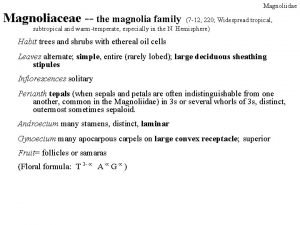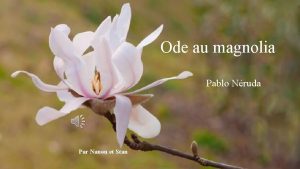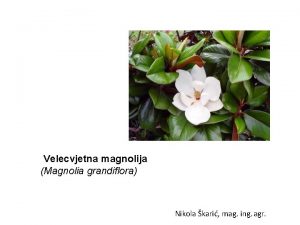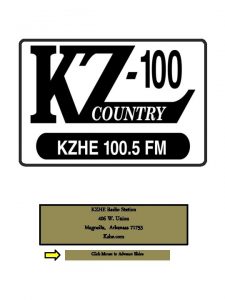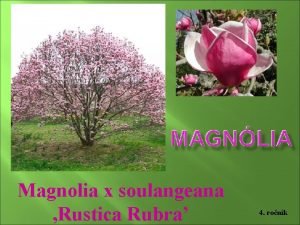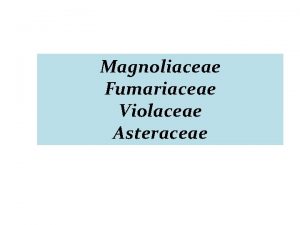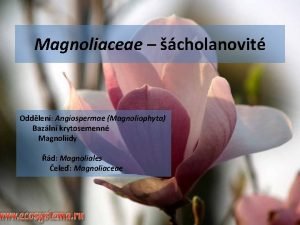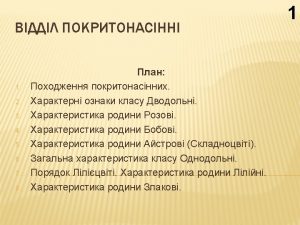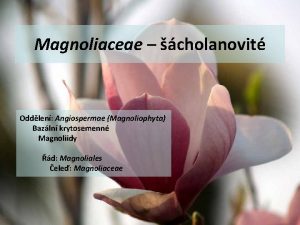Magnoliaceae The Magnolia Family Magnoliaceae the magnolia family




















- Slides: 20

Magnoliaceae The Magnolia Family

Magnoliaceae (the magnolia family) • 2 main genera worldwide, both represented in Delaware • Magnolia (240 worldwide) • Liriodendron (2 worldwide) • Tropical and temperate regions • Most species are small to large trees • Stems and leaves of the Magnoliaceae contain one-celled oil glands • Flowers solitary, perfect, showy • Fruits are varies within family, most common is aggregate of follicles • Receptacle elongated, becomes woody as fruits mature • Stipular scars go all the way around the twig • Popular ornamentals and shade trees • Not commercially important • Traditional medicinal uses

sweetbay magnolia Magnolia virginiana (Magnoliaceae) • Elliptical leaves • Evergreen farther south, deciduous here • Leaves dark green above, white below • Twigs have a spicy taste • 2” fragrant yellow flowers in spring • Fruit = 2” aggregate of capsules with bright red seeds inside • Smooth gray bark • The only magnolia native to Delaware • Common as a small tree on moist to wet sites throughout Delaware • A good choice for ornamental planting where you need a small tree

southern magnolia Magnolia grandiflora (Magnoliaceae) • Evergreen with large elliptical leaves • Many parts rusty tomentose – leaf undersides, buds, twigs • Stout twigs • Big white flowers in spring • Fruit, aggregate, contains bright red capsules • Smooth gray bark cracks to form plates • Native in southern swamps, not in DE • Planted throughout Delaware

yellow-poplar Liriodendron tulipifera (Magnoliaceae) • Large leaf with truncate apex • Valvate buds • Bark furrowed with zig-zag ridges, brown to gray • Showy flowers in spring, look like tulips • Fruit is an aggregate of samaras. Samaras fall off to leave “toothpick” • Native throughout Delaware • A very tall, straight forest tree • Shade-intolerant, early successional • Wood is valuable, used for cabinets & furniture

Ulmaceae The Elm Family

Ulmaceae (the elm family) • 15 -18 genera, around 100 species – mostly shrubs or trees • Temperate to tropical, especially in the northern hemispere • Delaware has two native genera • Ulmus – elm • Celtis – hackberry • Leaves alternate & simple, stipulate • Often inequilateral leaf bases • Plants can be synoecious, monoecious or polygamous • Inflorescence of solitary or clustered axillary flowers • Flowers perfect or imperfect, petals absent • Fruit a samara or drupe

Ulmus – Delaware’s two elms Ulmus americana and Ulmus rubra • Samaras = seeds with papery wings around them • Leaves doubly serrate, prominent veins, inequilateral bases • Bark has winding flat-topped ridges • Vase-shaped form • Flowers in early spring, rather inconspicuous

Delaware’s two elms – Side by Side Leaves Flowers Samaras Twigs American elm (Ulmus americana) slippery elm (Ulmus rubra) Sometimes scabrous, sometimes not Always very scabrous (90 -grit sandpaper) Long stems Deep notch at apex, ciliate margins Not scabrous Very short stems Emarginate apex, smooth margins Scabrous

Ulmus Dutch elm disease was introduced around 1930 and has killed most of our American elms. Other diseases have further reduced this genus to secondary status in the USA. A diseaseresistant variety of Ulmus americana called Princeton elm is now available, but whether we’ll see a resurgence of the elms remains to be seen….

hackberry Celtis occidentalis (Ulmaceae) • Leaves ovate to lanceolate, serrate except near the base • Often has deforming insect galls all over the leaves and twigs • Warty bark • Zig zag twigs • Fruit a ½ inch drupe, purple, September • A small tree • Native in Delaware’s forests, but not common. Occasional ornamental. WARTY BARK

Japanese zelkova Zelkova serrata (Ulmaceae) • Planted throughout Delaware as a street tree • Not native but not invasive • Has replaced many American elms killed by Dutch elm disease • Serrate leaf margins (not doubly serrate like elms) • Drupes instead of samaras • Branches angle steeply up from trunk

Moraceae The Mulberry Family

Moraceae (the mulberry family) • 40 -70 genera and more than 1, 000 species worldwide, mainly tropical • Only 2 genera are indigenous to temperate North America • Morus (mulberry) • Maclura (Osage-orange) • Shrubs or trees (rarely herbs) usually with milky sap • Leaves alternate, simple, stipulate, • Plants monoecious or dioecious • Inflorescence variable, usually reduced or condensed, petals absent • Fruit usually a drupe. In most genera the densely clustered flowers and the accessory tissue ripen together as a multiple fruit- some quite large

Morus – Delaware’s two mulberries Morus rubra and Morus alba • Fruit = multiple of drupelets resembling a raspberry. • Leaves variably lobed with 0 -3 lobes. Milky sap oozes from base of petiole when leaf is pulled from twig. • Bark has shallow furrows. • Small trees. Our mulberries are not commercially important but the fruits are eaten by birds and other animals.

Delaware’s two mulberries – Side by Side Leaves Fruit red mulberry (Morus rubra) white mulberry (Morus alba) Scabrous above Smooth and shiny above Dark purple Tolerance Shade tolerant Native? Native, somewhat uncommon Various colors but never dark purple Intolerant Invasive from China, very common

Osage-orange Maclura pomifera (Moraceae) • Cannot be misidentified if fruit is present. A multiple of drupes that looks like a softball-sized green brain. Oozes a milky sap when crushed. • Twigs have sharp thorns. • Leaves have long acuminate tips, bleed milky sap. • Orange deeply furrowed bark on old trees. • Wood is used for bows. • Originally from Arkansas and Texas. • Found in hedgerows in Delaware.

Aquifoliaceae The Holly Family

Aquifoliaceae (the holly family) • 4 genera, 400 species. Cosmopolitan • Shrubs or trees • Leaves alternate, rarely opposite, simple, stipluate • Plants synoecious or dioecious • Inflorescence of solitary or clustered axillary flowers • Fruit a drupe or berry

American holly Ilex opaca (Aquifoliaceae) • Easy to ID with bristly, stiff, dark green, evergreen leaves • Smooth gray bark • Dioecious, with female trees producing red drupes • Delaware’s state tree • Very shade tolerant but small size when full-grown • Common throughout DE in the understory • Formerly important commercially for holiday wreaths • Wood is used for inlay and decoration • Birds eat the berries
 Floral formula of magnoliaceae
Floral formula of magnoliaceae Ciri ciri famili magnoliaceae
Ciri ciri famili magnoliaceae Magnolia neruda
Magnolia neruda Zimzelena magnolija
Zimzelena magnolija Dendrolgia
Dendrolgia Magnolia bakery cake prices
Magnolia bakery cake prices Kzhe magnolia arkansas
Kzhe magnolia arkansas Tying a big tail on a small kite
Tying a big tail on a small kite Magnolia siebolda uprawa
Magnolia siebolda uprawa Picea abes
Picea abes Magnolia grove houston
Magnolia grove houston Krenec
Krenec Esempio di haiku
Esempio di haiku Phối cảnh
Phối cảnh Một số thể thơ truyền thống
Một số thể thơ truyền thống Các châu lục và đại dương trên thế giới
Các châu lục và đại dương trên thế giới Thế nào là hệ số cao nhất
Thế nào là hệ số cao nhất Hệ hô hấp
Hệ hô hấp Số nguyên tố là số gì
Số nguyên tố là số gì Tư thế ngồi viết
Tư thế ngồi viết Hát kết hợp bộ gõ cơ thể
Hát kết hợp bộ gõ cơ thể
